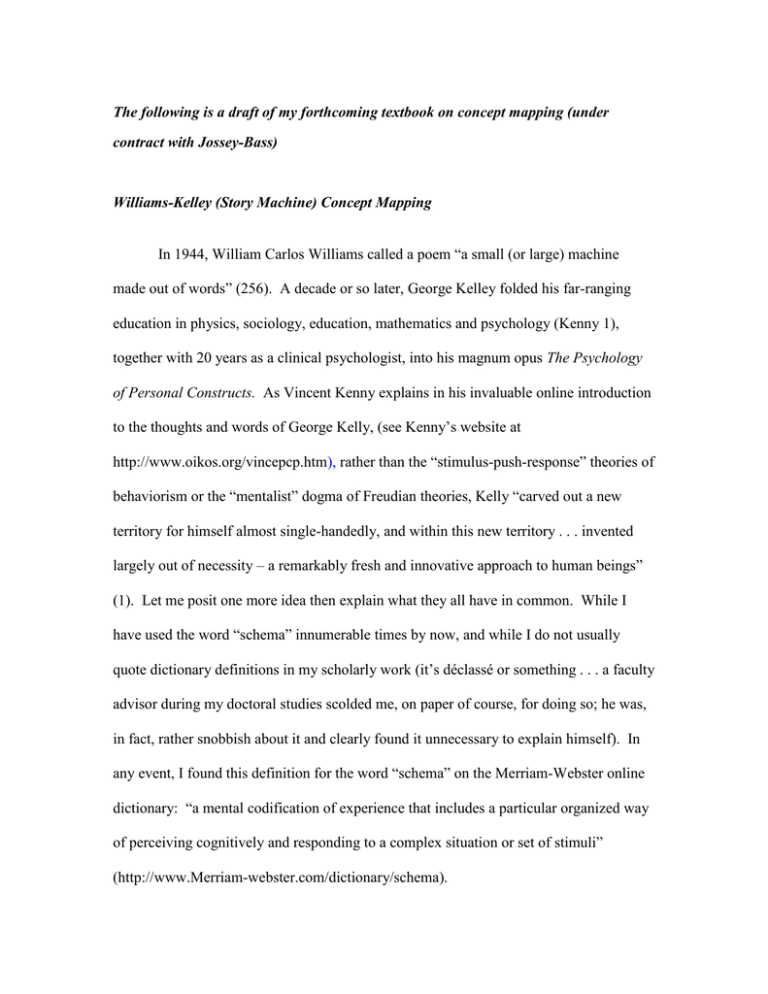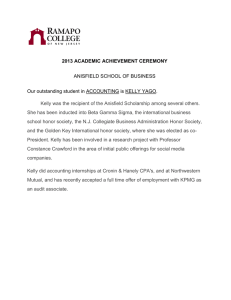The following is a draft of my forthcoming textbook on... contract with Jossey-Bass)
advertisement

The following is a draft of my forthcoming textbook on concept mapping (under contract with Jossey-Bass) Williams-Kelley (Story Machine) Concept Mapping In 1944, William Carlos Williams called a poem “a small (or large) machine made out of words” (256). A decade or so later, George Kelley folded his far-ranging education in physics, sociology, education, mathematics and psychology (Kenny 1), together with 20 years as a clinical psychologist, into his magnum opus The Psychology of Personal Constructs. As Vincent Kenny explains in his invaluable online introduction to the thoughts and words of George Kelly, (see Kenny’s website at http://www.oikos.org/vincepcp.htm), rather than the “stimulus-push-response” theories of behaviorism or the “mentalist” dogma of Freudian theories, Kelly “carved out a new territory for himself almost single-handedly, and within this new territory . . . invented largely out of necessity – a remarkably fresh and innovative approach to human beings” (1). Let me posit one more idea then explain what they all have in common. While I have used the word “schema” innumerable times by now, and while I do not usually quote dictionary definitions in my scholarly work (it’s déclassé or something . . . a faculty advisor during my doctoral studies scolded me, on paper of course, for doing so; he was, in fact, rather snobbish about it and clearly found it unnecessary to explain himself). In any event, I found this definition for the word “schema” on the Merriam-Webster online dictionary: “a mental codification of experience that includes a particular organized way of perceiving cognitively and responding to a complex situation or set of stimuli” (http://www.Merriam-webster.com/dictionary/schema). Here is what I find the above concepts have in common and how I find that commonality useful: the one essential my students tend to resist in constructing their stories is structure. Translated into practice, this resistance means that creative writing students want either to act as recording secretaries for their own experiences and call them "stories" or they want to wait for pure inspiration to knock them sideways before they write anything at all. When that doesn’t happen, I hear about how they just “couldn’t get started.” While I have discussed my idea and practice of “reverse engineering” extant story lines to help my students perceive a story’s structure, it’s not always easy for them to translate this practice into weaving the raw elements of their own life experiences into fiction. What’s more, at a very basic level, they have trouble turning the vague and skewed memories they have of the people who have influenced their lives into the structured creation of characters. While it is all very well and good to teach them that characters tend to come in contrasting pairs, and to show them how this functions in stories or movies we discuss, my recent research into the personal construct theories of George Kelly suggest that perhaps working some of his specific hypotheses into human behavior into recorded concept maps might make the ideas clearer to my students and help them to use such seemingly mechanical, or “machine-like” structural approach as creative inspiration. (T) After all, Kelly is not alone in distinguishing between “reality” and our construct of it. This idea has been posited by educators and philosophers alike for a long time. Perhaps students can be made to see that such a hypothesis closes the gap between so-called real life and fiction. If they can see that we construct our versions of reality anyway, perhaps they can see how easily applicable this can be to the creation of fresh fiction. Having a basic understanding of Kelly’s corollaries would be useful in both writing and literature classes, especially those with multi-disciplinary facets, such as my humanities theme class. Concept mapping can be a handy way to encapsulate his theories into both hierarchical map clarifying the major divisions of his hypotheses and corollaries. In addition, more dynamic relationships between individuals' behavior can be added as dynamic concept maps that be explored and even added to in whole class discussion. Once students have a basic understanding of these constructs, we can begin translating them into writing inspiration, i.e. we can move from reverse engineering to fabricating parts for our own machines. The figures that follow offer some basic instruction on Kelly’s personal construct theories. Consider, for instance, Kelly’s “Individuality Corollary,” which posits that each of us differs from each other of us in our “construction of events” (6). Concept mapping several perspectives of the same event might help one to construct a sophisticated story with multiple points of view or even something metafictional where story-lines converge or diverge, creating stories within stories. Cross-linking commonalities between aspects of differing points of view might indicate where characters can come together in consonance or in conflict; it might even suggest plot points where characters might meet to begin their interactions. Kelly’s “Dichotomy Theory” posits that “a person’s construction system is composed of a finite number of dichotomous constructs,” some of which may remain hidden from the individual himself or herself, apparently (Kenny 11). Kelly used this idea in his clinical practice to illuminate his client’s personal constructs by looking for the dichotomous opposite of that client’s declared stances. For instance, knowing that a client considers himself “ambitious” is more helpful if you also know that the client defines the opposite of “ambitious” as “lazy,” or if another client considers the opposite of “ambitious” as “relaxed.” While the first oppositional pairing might reveal why Client A is so stressed out, the second could help Client B understand why he has not yet reached his full potential in life (11-12). Such “dichotomous thinking” is common; we clearly tend to see in oppositional, black-and-white terms, which some writers, especially those new at the game, reveal in abundance. Rather than ignoring this tendency, I’m considering how we might find it useful in creative writing. While polar opposites stand in stark contrast to each other, and this is part of their dubious charm, in terms of characterization, this same territory, the poles of opposition, also tend to be where the clichés live. For instance, I’m working on a series of exercises to help students find a more nuanced way to create contrast among their characters than simple polar opposition. By acknowledging and using the tendency to think in dichotomous clichés, perhaps we can find a way to make this tendency explicit, versus implicit. Clarity, in terms of selfawareness and in creativity, often depends on this distinction. Once such dichotomous tendencies have been “foregrounded,” so to speak, they can be made useful. What once worked to flatten perceptions and deaden language can become an instrument to complicate perceptions and enliven language. The following screen captures of a cmap recording demonstrate how one might present these concepts to a creative writing class and then call on them to work from clichés to more nuanced characterizations. The goal, of course, is to enrich their character conceptualization so they create rounder and more believable characters in their own stories, as well as enrich their use of language. (I will eventually expand this practice to helping my literature students perceive extant characters in more detail versus judging them solely on the basis of whether their actions seem reasonable and exemplary or not – I never give up on the idea of finding a way to add more empathy to their youthful stance towards their fellow humans, real or fictional.) See Figures 3-10 and 3-11 which follow for examples. Fig. 3-10: Character foil “machine” invites students to add more nuance to their idea of character foils. This would help both literature and creative writing students to enrich their understanding of characterization. I could also use dichotomous thinking to help students build their vocabulary, which tends to be rather impoverished. It’s a vicious cycle: a poor vocabulary tends to inhibit the ability to think in complex ways and that inhibition devalues a rich vocabulary. However, they do love extra credit opportunity. It might be useful to offer extra credit for homework assignments involving adding nuance to their vocabularies with follow-up in-class concept mapping practice. For instance, I could help them build their descriptive powers by find more subtle distinctions between pairings such as “hot” and “cold,” or between “good” and “bad,” “kind” and “unkind,” and/or “dark and light,” for example. In class, we could build a simple concept map with students calling out their “findings” while I add them to the map, as follows: Fig. 3-11: The above shows a concept map recording playback paused at step 71 in the process of “morphing” from character to word machine. (See Chapter 4 for more information on recording the creation of concept maps.) Another Kellean hypothesis I wish to explore is the “Fragmentation Corollary,” which can be summarized thus: “A person may successively employ a variety of construction subsystems which are inferentially incompatible with each other” (Kelly qtd in Kenny 12). In simple terms, picture two seemingly conflicting behaviors at the bottom of a concept map. Although they seem incompatible and one might find oneself baffled as to how one person may exhibit such seemingly incompatible behaviors, following a concept map of his or her beliefs further and further up the hierarchy of beliefs, one will invariably find a superordinated idea that accommodates both behaviors. In creative writing terms, this concept can be a gold mine. Time after time, I have read the advice that characters should be “consistently inconsistent.” While this is clear enough in theory, it is harder to explicit how one goes about creating consistently inconsistent behaviors without creative characters who are simply too inconsistent to seem human. To capitalize on these connections, I’ve begun experimenting with the idea of using the CmapTool’s recording Tool to “transform” simple Kelly behavioral concept maps into creative writing schemata. (There are detailed instructions on using the program’s recording tool, which is, by the way, quite user-friendly and intuitive, in the “More Sophisticated Uses” section of Chapter 4.) In other words, this program can help me help my students move from reversing engineering human behavior to forward engineering their characters’ behavior from a Kellean perspective. The screen captures that follow show a CmapTool recording “playback” at two different stages of the transformation. In the first, the playback shows the construction of a simple demonstration of Kelly’s Fragmentation Corollary. Working from two simple, yet contradictory behaviors, the map constructs itself “backwards,” i.e., from the bottom up with the two contradictory behaviors, then upwards towards a superordinated position in the hierarchy. While this example is quite simple, more hierarchical levels can be constructed once the basic structure is clear. After all, really contradictory behaviors might find no logical reconciliation that close to the behavior itself in terms of our personal constructs. That would be too obvious to create any mystery for the therapists or the writers to deconstruct. Fig. 3-12 (above) and 3-13 (below): The above captures the playback of a “bottom-up” construction demonstrating Kelly’s Fragmentation Corollary of human behavior. The figure below shows the same playback paused at a later step translating the corollary into a character construction schema. Please also note the nested concept map icon on both versions of this map. Clicking them accesses additional information on both Kelly’s personal construct theories and more information on characterization, contrast and such ideas as “hamartia.” Nesting is explained later in Chapter 4, as is the additional option of adding a “call out” button to such concept boxes as the “’X’ = hamartia” concept box in this map to display additional information to maps without overwhelming them with too much information at once. See the section titled “A Few More Sophisticated Cmap Possibilities” in Chapter 4.

